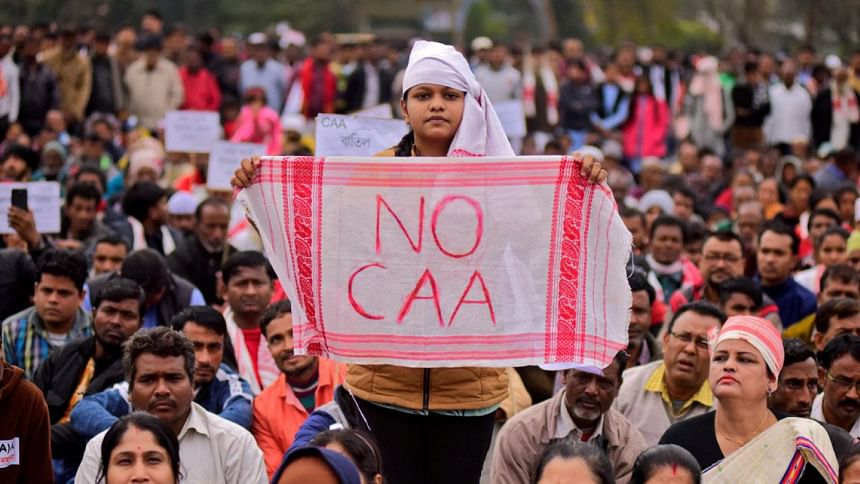Of human migration and citizenship in Assam

On October 17, a constitution bench of India's Supreme Court, in a 4:1 majority judgment, upheld the constitutionality of Section 6A of the Citizenship Act, 1955. This provision allows immigrants from erstwhile East Pakistan (now Bangladesh) residing in Assam to secure Indian citizenship. Political parties across ideological lines in Assam welcomed the ruling.
"This verdict re-established the rationality of the Assam movement and the Assam Accord. We pay tribute to the martyrs on this historic occasion. We demand again that every clause of the Assam Accord be fully implemented," said the All Assam Students Union, which had spearheaded a six-year violent street agitation from 1979 to 1985 against "illegal" immigrants from across the border in the north eastern state. They further said that the apex court verdict was "historic" and a second victory in the fight to save Assam's identity and demography stating, "It has been established that the Assam agitation was undertaken for genuine reasons." Main opposition Congress has also welcomed the top court ruling. After all, the party-led central government headed by Rajiv Gandhi was one of the signatories to the tripartite 1985 Assam Accord whose clause 6A was challenged in the Supreme Court.
Section 6A was added to the Citizenship Act of 1955 as a special provision addressing citizenship issues under the Assam Accord, an agreement signed between the then Prime Minister Rajiv Gandhi's administration, the All Assam Students' Union (AASU), and Assam's then Chief Minister, Prafulla Kumar Mahanta. According to Section 6A, individuals who arrived in Assam between January 1, 1966, and March 25, 1971, from specific territories including Bangladesh, and have remained resident there since, must register under Section 18 to obtain citizenship. However, under the Assam Accord's provisions, they were prohibited from registering as Indian citizens for a decade from the day of their detection. Those who arrived after March 25, 1971, as stipulated in the Assam Accord, are to be deported. Consequently, Section 6A designates March 25, 1971—coinciding with the start of the Bangladesh Liberation War—as the cutoff date for granting Indian citizenship to immigrants, particularly those from Bangladesh.
The majority ruling by the top court stated the cut-off date of March 25, 1971 for those who entered Assam was rational as it was the date when the Bangladesh Liberation War started and the objective of clause 6A must be seen in that backdrop. The majority was of the view that Section 6A was "neither over-inclusive nor under-inclusive."
The majority ruling by the Supreme Court upheld March 25, 1971, as a reasonable cut-off date for individuals entering Assam, noting that this date marked the beginning of the Bangladesh Liberation War and provided essential context for the purpose of clause 6A. It further concluded that Section 6A was "neither over-inclusive nor under-inclusive."
The validity of Section 6A was challenged in the Supreme Court primarily by the Assam Sanmilita Mahasangha and other petitioners, who argued that this provision unfairly singled out Assam, enabling large-scale immigration that had significantly. The petitioner's claim was that granting citizenship to immigrants claiming entry before March 25, 1971, was harming Assam's identity, and they instead called for a cut-off date of 1951 to identify and deport illegal immigrants. They had contested Section 6A in 2012, calling it discriminatory, arbitrary, and illegal as it set a different cut-off date for regularising illegal immigrants in Assam compared to the rest of India.
Now, since the top court has refused to recognise 1951 as the cut-off year for citizenship in Assam, will it hit Assam's current Chief Minister Himanta Biswa Sarma's plank of Hindutva and Assamese identity politics? Will it help settle the debate over the 1951 versus 1971 cut-off year for identifying undocumented immigrants in Assam?
Some more questions remain unanswered even after the apex court judgment. One, has it settled or furthered the debate on undocumented immigration and citizenship in the states bordering from erstwhile East Pakistan and later Bangladesh? Two, how will the top court ruling play out in the political landscape of Assam, where fresh assembly elections are due in 2026? Thirdly and most importantly, certain observations by the Supreme Court bench on the question of citizenship could have a bearing on the pending petitions challenging the Citizenship Amendment Act (CAA) brought by the Modi government in 2019 giving citizenship to those persecuted Hindus, Sikhs, Christians, Buddhists, Parsis and Jains from Bangladesh, Pakistan and Afghanistan who came to India till December 2014. The CAA was introduced as Section 6B of the 1955 Citizenship Act, and its enactment had sparked violent street protests not only in Assam, but in several other parts of India on the grounds that it keeps out Muslims from its ambit. Fourthly, the apex court ruling of October 17 does not provide an answer to the question as to what happens to those who migrated in the five decades since March 25, 1971, the cut-off date under 6A of the 1955 citizenship law.
A section of legal luminaries, including senior advocate Kapil Sibal, viewed the Constitution bench's remarks on citizenship as being inclusive. They particularly pointed to Justice Surya Kant's observation that the principle of fraternity cannot be selectively applied and citizenship cannot be interpreted in a negative manner that applies to a particular section of people living in Assam while another lot are labelled "illegal immigrants." Kant stated, "Our reading of the Constitution and precedents is that fraternity requires people of different backgrounds and social circumstances to 'live and let live'".
Agreeing with the majority view, Chief Justice of India D Y Chandrachud said while the Constitution recognises a "right to conserve culture," the provision must be read in light of the "multicultural and plural nation that India is." Ultimately, it seemed the court clearly rejected the contention of the petitioners that Section 6A is in violation of Article 29 because it permits people from Bangladesh who have a distinct culture to be ordinarily residents in Assam and secure citizenship which infringes upon their right to conserve Assamese culture.
Pallab Bhattacharya is a special correspondent for The Daily Star.
Views expressed in this article are the author's own.
Follow The Daily Star Opinion on Facebook for the latest opinions, commentaries and analyses by experts and professionals. To contribute your article or letter to The Daily Star Opinion, see our guidelines for submission.

 For all latest news, follow The Daily Star's Google News channel.
For all latest news, follow The Daily Star's Google News channel. 











Comments